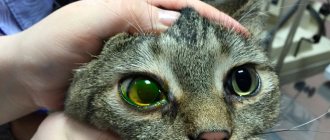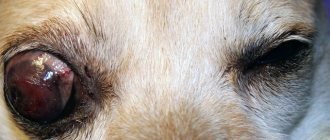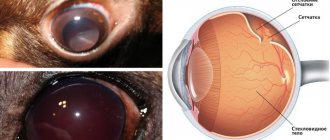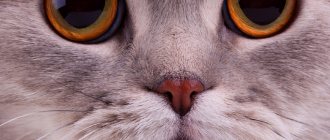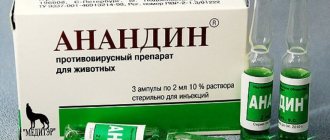Vision plays an important role in the lives of living creatures, and dogs are no exception. The eyes help to receive a huge flow of information, easily navigate space and avoid dangers. It is not surprising that dogs with complete or partial loss of vision may experience a number of problems, decreased appetite, and changes in character. Therefore, if there are any signs indicating the development of eye diseases, you should immediately contact a veterinarian.
What is the danger of squinting?
The sudden appearance of a dog's habit of squinting one or both eyes can be a sign of a number of serious problems, including the occurrence of corneal erosion, leading to partial loss of vision. In the initial stages, it is difficult to identify the disease, but squinting is a characteristic symptom. If you do not pay attention to this problem, clouding of the cornea (a whitish spot) may soon occur. If left untreated, erosion quickly turns into an ulcer of the stratum corneum. The causes of the disease are very different:
- infection in the eyes,
- allergic reaction,
- corneal injury,
- dry eye syndrome, etc.
In any case, injury to the stratum corneum is accompanied by pain and discomfort, which force the dog to close the unhealthy eye.
How to bleach dog fur at home
You can preserve the coat of a white dog using home remedies, but the results do not last long compared to commercial products.
If it is not possible to regularly bathe a white dog, then you can keep the coat clean by dry brushing. To do this, use corn starch and baby powder. It is better to clean it outside or cover the floor surface with newspapers. Then starch (powder) is generously applied to the wool and the product is distributed using massaging movements of the hands. After this, carefully remove the starch with a brush.
If the fur has acquired a gray or reddish tint, baking soda, which is mixed with a small amount of water to a paste consistency, gives a good result. The paste is applied to the yellowed area, left to absorb for a few seconds and washed off with water.
You can bleach your dog's fur at home using a bleaching paste you prepare yourself. To do this, mix 3% hydrogen peroxide and milk of magnesia (magnesium hydroxide, laxative), 1 tsp, in equal quantities. corn starch. Mix all components to a homogeneous paste. The paste is applied to the stains and allowed to dry for several hours. The paste is then removed by thoroughly combing the coat using conditioner. It is important to prevent the dog from licking the paste, therefore, if the dog is able to reach the treated area with his tongue, a protective collar should be used.
Tear tracks in white dogs are a common problem and can be painful. Therefore, first of all, you should visit a veterinarian to rule out all possible causes that require treatment. Red or brown tear tracks can be infectious. Therefore, in some cases, antibiotics may be prescribed, after treatment with which the natural color is restored. To remove tear tracks that are not caused by illness, dog owners find apple cider vinegar effective, 1 tsp daily. added to dogs' drinking water.
Tear tracks can be removed at home in another way. To do this, equal amounts of water and 3% hydrogen peroxide are mixed. The resulting solution is used to remove tear tracks using a cotton swab. It is important to be careful and avoid getting the solution in the dog’s eyes. Then the treated area is cleaned with plain water, removing any remaining dirt and solution.
Another problem that spoils the appearance of the animal is redness of the fur on the face, belly, and paws. The coloring agent gets onto the fur through the dog's saliva when it licks its paws, as well as through urine. In addition, food allergies can be the cause of coat staining. To prevent the appearance of a red tint, you should:
- give purified drinking water, since ordinary water may contain elevated levels of iron;
- provide high-quality dry food without dyes and with optimal protein content (no more than 20-30%);
- exclude natural products that contain iodine and copper in large quantities and affect hair color - carrots, beets, seaweed;
- use a high-quality coat conditioner after washing your dog, which strengthens, moisturizes the hair and makes it less prone to coloring;
- tie the hair on the head in a bun so that it does not get into the eyes and does not have an irritating effect, leading to excessive tearing and, as a result, the appearance of tear tracks;
- after walking, wash the belly area to remove residual urine, wash the paws, and after eating, wipe the beard with a damp cloth or put on a special bib.
If the dog does not participate in exhibitions, then it is advisable to trim the hair on the paws, near the mouth, and in the eye area to prevent coloring.
If the eyes fester
Very often, inflammatory diseases of a dog's eyes can be accompanied by the discharge of pus. However, mucous and purulent discharge should not be confused. So, the appearance of mucus is not always a sign of illness. It may indicate that a speck or hair, dust or other contaminants have entered the eye, and may occur when overfeeding with certain foods and treats. When these irritants are removed, the discharge should stop.
As for pus, it can appear when the eyelid, conjunctiva or cornea are injured, or when pathogenic microflora enters the eye. The insidiousness of such injuries is that obvious symptoms can appear only after a few days, when the inflammatory process has gained strength.
Another common cause of purulent exudate is conjunctivitis. One of the first symptoms of this disease is severe itching. Also characteristic are redness of the eyes, increased lacrimation, swelling of the eyelids, and the presence of white, grayish or greenish discharge.
Whitening shampoos for dogs
Most dog coat bleaching shampoos contain a bluing agent , which gives white fur a blue tint that is perceived as white by the human eye. The optical illusion is achieved due to the fact that the blue or purple color coloring the ends of the hair reflects light, and the coat appears lighter, whiter. But the white effect is achieved only in the presence of faint yellow spots. After using a bluing agent, it is necessary to wash it again with regular shampoo so that the coat does not acquire a concentrated blue color. You cannot use several whitening shampoos at the same time. For example, using a bluing shampoo after a bleaching shampoo can cause your hair to turn blue.
Enzyme-based lightening shampoos remove yellow stains from saliva and tears, allowing you to achieve the desired result. But the product acts harshly, removing the outer layer of each hair. Therefore, it is not recommended to use enzymatic shampoos frequently. It is usually used with a good conditioner that has a restorative effect.
Whitening shampoos for dogs contain aggressive chemicals that help achieve whiteness, but if used incorrectly can cause dry, irritated skin. Such aggressive substances include hydrogen peroxide, which increases the pH level, thereby bleaching hair.
The effect of all shampoos is enhanced by using warm water, which promotes deeper cleansing of impurities from the hair. But it is better to rinse off the shampoo with cool water, which helps close the hair scales. The active ingredients are fixed inside the hair, after drying, maximum reflection of light occurs, achieving the effect of whiteness and radiance. Beaphar, 8in1, Mr. cosmetics work well. Bruno, Espree, All Systems, Chris Christensen.
Eye injuries
Any eye injury is very serious, regardless of what caused it. In breeds with protruding eyes (pugs, bulldogs, Pekingese, Yorkshire terriers, etc.), due to breed characteristics, injuries occur more often, and the inflammatory process is more pronounced. Key signs of eye injury in a pet may include:
- prolonged squinting;
- discharge from the eye of fluid with bloody inclusions, transparent or containing pus;
- changed behavior of the dog (usually the dog does not allow you to touch its face, whines, may bite when the owner tries to touch the injured eye, etc.);
- loss of transparency of the cornea, the appearance of whitish, bluish-tinged or bloody spots on it.
So-called contusion injuries, which develop as a result of an impact to the eyes, can also pose a danger to the pet’s vision, which often leads to retinal detachment or rupture, intraocular hemorrhages, including swelling of the optic nerve. Moreover, unlike external ones, internal damage of this kind can remain unnoticed by the animal owner for a long time. The possibility of vision restoration is directly dependent on the timing of receiving the necessary medical care. Therefore, if you have any alarming symptoms, you should take your pet to the veterinarian.
Heterochromia and its causes
Huskies with different eyes are unique. As a rule, this “diversity of eyes” includes two basic shades: brown and blue. However, sometimes a pet can have other eye colors. Husky called Harlequin is the name given to these extravagant representatives of the breed. The phenomenon itself has a special term - heterochromia.
Interestingly, a representative of this breed can have two types of heterochromia - complete or sectoral. In the first case, the pet’s eyes will be distinguished by color, but in the second, one eye combines two shades. It is believed that beautiful, odd-eyed huskies are already born as such, that is, heterochromia is a hereditary phenomenon.
Such “failures” occur due to a lack of the special pigment melanin in the body. If its concentration is too low, a similar result may occur. Sometimes the cause of this phenomenon is the crossing of a brown-eyed pet with a blue-eyed pet.
Remember that in some cases, different husky eyes are the result of some kind of illness. For example, you treated your pet with potent drugs for a very long time and over time began to notice how the shade of his eyes changed. If you have a problem like this, you should contact a specialist as soon as possible. In general, the eye shades of this breed of dog can be truly varied. Which one is more beautiful is up to you to decide.
We recommend this article:
The main differences between the Husky and the Laika breed
Cloudy eyes
The cause of clouding of the cornea of the eye can be undetected injuries, accumulation of cholesterol or calcium crystals in the cornea, germination of blood vessels, accumulation of fluid or purulent inclusions. This problem can also be caused by a number of diseases: keratitis, glaucoma, corneal erosion, as well as degenerative changes.
It is worth noting that the concept of “pupil clouding” does not exist, since the pupil is a hole in the iris. That is, in this case we are talking more about clouding of the lens, which is located at the level of the pupil. The causes of the disease may be excess fluid or, conversely, drying out.
Why do they have different eyes?
In science, this phenomenon is called pigment imbalance of the iris or heterochromia. Different colors can be congenital or acquired during the pet's life.
Scientific explanation
The variety of colors in the irises is a consequence of the lack or excess concentration of a special pigment - melanin in the animal's body. The concept has Greek roots, and translated into Russian means “a different color.” The content of this pigment becomes a decisive factor in determining eye color. If its balance is disturbed , heterochromia occurs. This means that there is too little or too much melanin.
Varieties
This feature can be expressed in full or in part - by sector. The first type implies a clear difference in the shades of the irises. In the second case, different tones are present in one eye, part of which is painted in a different color. Therefore, one eye can be blue, and the other half brown with blue splashes.
Pigment imbalance is typical not only for representatives of this breed. This is typical for cats, horses, and cows. Sometimes it happens to humans.
Redness of the eyes
The causes of red eyes in a dog can be different:
- allergic reaction (general or local) to certain types of food, dust, plants, medications, etc.;
- a number of eye diseases, including plasmama (as a result a dense, lumpy film appears on the cornea), vascular keratitis (associated with the growth of capillaries into the iris during advanced inflammatory processes), etc.;
- injuries, foreign bodies, infectious diseases, etc.
In most cases, long-lasting redness of the eyes is a dangerous symptom. Owners need to contact a veterinarian as soon as possible. With timely treatment, it is possible to avoid relapses and preserve the pet’s vision, and if hyperemia of the mucous membranes is associated with a disease such as babesiosis, then save a life.
In some cases, emergency eye care may be needed. First of all, we are talking about injuries and possible infection. Eye drops "Iris" is a long-acting ophthalmic antibacterial drug based on gentamicin sulfate. It can be prescribed by a veterinarian for acute and chronic conjunctivitis, keratitis, meibomitis, blepharitis, keratoconjunctivitis, uveitis. As a prophylactic agent in case of injury to a dog's eyes, the drug is instilled into the conjunctival cavity for 3 days. The uniqueness of Iris drops is that they easily penetrate into the intraocular environment and do not allow the development of infection. Before using drops, preliminary consultation with a specialist is recommended.
Most common colors
Blue-eyed or brown-eyed huskies are a worthy choice for a connoisseur of truly majestic and at the same time loyal varieties of dogs. It is imperative to understand what eye color is found in huskies, which shades are preferable and which are not. Interestingly, each breed of dog has its own “zest”.
When it comes to an extravagant four-legged creature, even the most inexperienced dog breeder will easily note the color of the eyes and the shade of the fur on the head (due to this characteristic, a representative of this breed is often compared to a wolf). What eye colors do huskies have? According to key species standards, they are:
- brown;
- amber;
- blue;
- olive
It is huskies with blue eyes that are considered the most recognizable. This color has a characteristic dark rim and looks very unusual. Most often it occurs in dogs with gray coat color or black and white representatives of the breed. As for white pets with expressive blue eyes, they are a real rarity. To find such a pet, you will have to try.
By the way, scientists have proven that it is the blue-eyed representatives of the breed (who also have a white coat) that are considered the most friendly towards the owner, they are very fond of outdoor games and, in general, cannot live without active pastime.
Similar article: How much does it cost and how to choose a husky puppy
Dogs of this variety with brown eyes are much more common. Moreover, for the most part, their coat color is much darker than that of the blue-eyed representatives of the breed. According to the standard, amber eye color is also acceptable: it is very warm and attractive. Which shade will be the most beautiful depends on your preferences.
We recommend this article:
Dog breeds similar to husky


